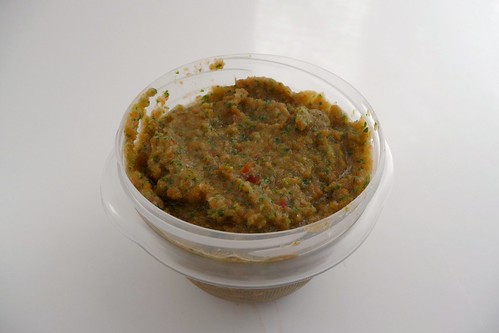 I've made a mean veggie stock in the past but the problem with it is that we use it up so fast, I'd have to make stock every Sunday just to keep up.
I started looking for a commercial bouillon every time we went to any kind of grocery store. Usually, all I found was a box of veggie stock (granted, I love Pacific Organic's stock) accompanied by all sorts of meat-based bouillons. Not a single veggie bouillon in sight, even in the frou-frou stores.
Then, in January, Heidi at 101 Cookbooks posted an incredibly simple raw bouillon recipe. It took me a while to get to making it, but finally did this month.
Boy, I wish I hadn't waited.
It's a great, simple and very flexible bouillon. It tastes wonderful. We used it last night in this creamy egg-lemon soup along with some chicken broth and I swear, it smelled just like the best chicken noodle soup you've ever tasted.
Please check out Heidi's post for her way of making this. One of the changes I made was because my husband seriously detests anise (and it's expensive here). The only thing we'd change about the batch we have in the freezer is to use roasted garlic instead of raw for the extra oomph of flavor. I've written that in as an option because going through 3 1/2 cups of concentrated bouillon is going to take us a while.
One word of warning: Yes, this calls for a lot of salt. Bouillon is preserved with salt and it will not be salty once it is reconstituted. The amount of salt has a secondary benefit - you can leave the jar in the freezer and it will still be scoopable.
I've made a mean veggie stock in the past but the problem with it is that we use it up so fast, I'd have to make stock every Sunday just to keep up.
I started looking for a commercial bouillon every time we went to any kind of grocery store. Usually, all I found was a box of veggie stock (granted, I love Pacific Organic's stock) accompanied by all sorts of meat-based bouillons. Not a single veggie bouillon in sight, even in the frou-frou stores.
Then, in January, Heidi at 101 Cookbooks posted an incredibly simple raw bouillon recipe. It took me a while to get to making it, but finally did this month.
Boy, I wish I hadn't waited.
It's a great, simple and very flexible bouillon. It tastes wonderful. We used it last night in this creamy egg-lemon soup along with some chicken broth and I swear, it smelled just like the best chicken noodle soup you've ever tasted.
Please check out Heidi's post for her way of making this. One of the changes I made was because my husband seriously detests anise (and it's expensive here). The only thing we'd change about the batch we have in the freezer is to use roasted garlic instead of raw for the extra oomph of flavor. I've written that in as an option because going through 3 1/2 cups of concentrated bouillon is going to take us a while.
One word of warning: Yes, this calls for a lot of salt. Bouillon is preserved with salt and it will not be salty once it is reconstituted. The amount of salt has a secondary benefit - you can leave the jar in the freezer and it will still be scoopable.
Adapted from 101Cookbooks
Original recipe featured in The River Cottage Preserves Handbook
Makes approximately 3 1/2 cups
Chop everything roughly and combine all but the salt and parsley in the bowl of a food processor. You may need to pulse several times between ingredients to make enough room, depending on your model3. Process to a coarse puree then add the parsley and salt. Puree until mostly smooth.
Remove to freezer-safe containers. Store only what you need in the fridge, the rest in the freezer. The bouillon will still be easily usable straight out of the freezer due to the high salt content.
Usage: 1 teaspoon of bouillon per cup of water.
Notes: